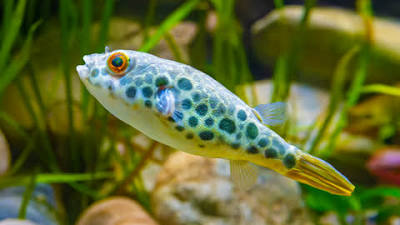Midwest Aquarium and Pond Supplier LLC
(193) Spotted Congo Pufferfish
(193) Spotted Congo Pufferfish
Precio habitual
$199.97 USD
Precio habitual
Precio de oferta
$199.97 USD
Los gastos de envío se calculan en la pantalla de pago.
Cantidad
No se pudo cargar la disponibilidad de retiro
The Spotted Congo Pufferfish (Tetraodon schoutedeni) is a popular freshwater pufferfish known for its active and curious nature, and its relatively peaceful temperament for a puffer. Its small size and engaging personality make it a favorite for specialized aquariums.
Appearance and Size
- Body: They have a rounded body shape and are typically brown or green with a lighter belly.
- Markings: Their body is covered in distinctive black spots or stripes.
- Size: They reach a maximum size of about 3 to 4 inches (7.5 to 10 cm).
- Teeth: Like all pufferfish, they have a beak-like structure of fused teeth that requires hard-shelled foods to prevent overgrowth.
Aquarium Care
- Tank Size: A single adult requires a minimum of a 40-gallon tank, but larger aquariums are recommended, especially for groups.
- Environment: They thrive in a heavily planted aquarium with plenty of hiding spots and a soft sandy substrate. A complex environment with driftwood, roots, and stones makes them feel more secure and encourages natural behaviors.
- Water Parameters: Maintain a temperature of 77–81.5°F (25–27.5°C), a pH of 6.5–7.5, and low nitrates (under 15 ppm).
- Filtration: Because of their high bioload, powerful and consistent filtration is essential. They do best with a moderate water current.
- Diet: As carnivores, their diet should consist of a variety of crunchy, hard-shelled foods like snails, shrimp, and crustaceans to help wear down their teeth. Frozen and freeze-dried foods can also be offered.
- Tank Mates: While generally peaceful for a puffer, they can be aggressive toward slow-moving or long-finned fish. Careful selection of tank mates is necessary.
Behavior
- They are active and curious, often exploring their environment.
- They can change color when stressed, often becoming dark green and hiding in the substrate.
- Like many puffers, they are highly intelligent and can learn to recognize their owner.
Share
No reviews

